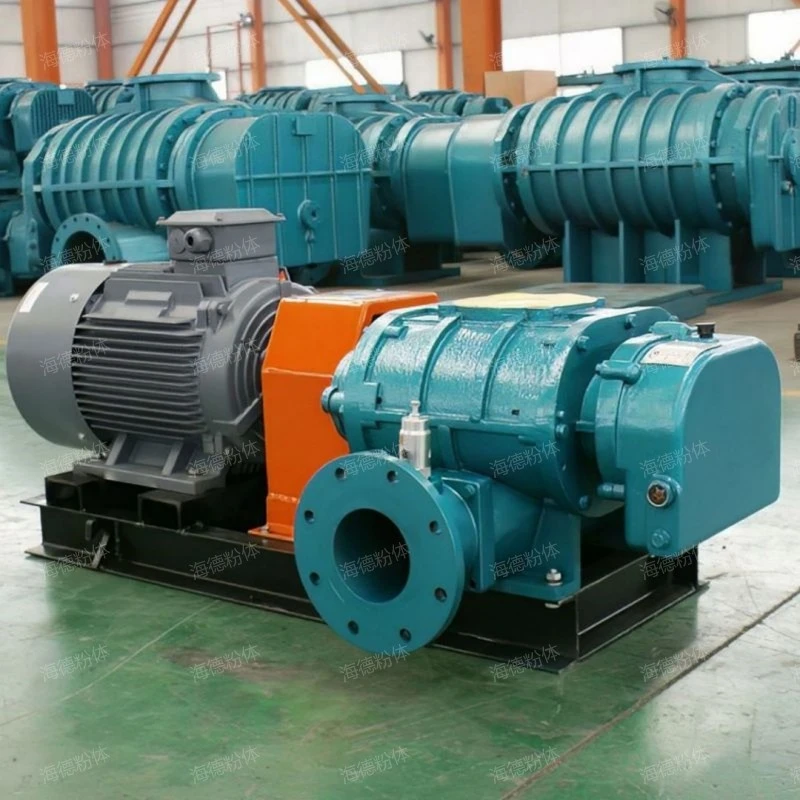Introduction to CO2 conveying Roots blower, how much is the price of the Three leaf Roots blower?
CO2 conveying Roots blowera rotary compressor that uses two lobed rotors to move relative to each other in a cylinder to compress and transport gas.,in the course of work,When the motor drives one impeller to rotate, the other impeller will rotate synchronously at the same speed and in the opposite direction under the action of the synchronous gear. In the process of rotation, because the gaps between impeller and impeller, impeller and casing, impeller and wallboard are very small, a vacuum state is formed at the air inlet, and air is sucked into the air inlet cavity under the action of atmospheric pressure. As the impeller continues to rotate, two blades of each impeller, the wallboard and the casing form a sealed cavity, and the air in the air inlet cavity is continuously brought to the exhaust cavity by the sealed cavity formed by the two blades. Because the impellers in the exhaust cavity are meshed with each other, the air between the two blades is squeezed out. After continuous inhalation and extrusion, air is continuously transported from the air inlet to the air outlet, completing the whole gas transportation process.,widely used in manufacturing industry, coal chemical industry, Pharmaceutical and chemical industries, Dust removal, port and other fields。
1、Brief introduction of CO2 conveying Roots blower
CO2 conveying Roots bloweris a double impeller synchronous compression machine, belonging to a positive displacement blower.,features include durable performance, smooth operation, convenient maintenance, convenient manufacture and run smoothly,be loved by our customers.。

CO2 conveying Roots blower
2、Structural advantages of CO2 conveying Roots blower
The CO2 conveying Roots blower has the following structure
- bearing
- rotator
- muffler
- impeller
- wallboard
It is used to support the rotation of the rotor and bear the weight of the rotor and the load during operation.
The core components are two identical lobed rotors, which usually adopt involute or epicycloid envelope design to ensure close cooperation during rotation and reduce leakage.
Used to reduce the noise caused by airflow pulsation when the CO2 conveying Roots blower enters and exits.
It is the rotating part of the CO2 conveying Roots blower, which is divided into two leaves and three leaves. However, due to many advantages such as smaller air pulsation, less noise and smoother operation, the three-leaf CO2 conveying Roots blower has gradually replaced the two-leaf CO2 conveying Roots blower.
It is mainly used to connect the casing with the impeller, support the rotation of the impeller, and play the role of end sealing.

CO2 conveying Roots blower
3、CO2 conveying Roots blower function
CO2 conveying Roots blowermultifunctional, with functions such as material fluidization, desulfurization oxidation, supply air, ventilation and dry,is a popular CO2 conveying Roots blower,the main structure includes bearing, rotator, impeller, case, fuel tank and so on,This CO2 conveying Roots blowerSimple structure and reliable operation.,the product looks atmospheric.,is a positive displacement blower with forced gas transmission characteristics.。

CO2 conveying Roots blower
4、Working principle of CO2 conveying Roots blower
CO2 conveying Roots blowerat runtime,The gas is compressed and transported by the relative rotation of a pair of trilobal rotors in the cylinder. Each trilobal rotor is supported by two bearings, and the relative position of the two rotors is always kept constant by using a pair of synchronous gears. During the rotation of the rotor, there are tiny gaps between impeller and impeller, impeller and casing, impeller and side cover, so there is no friction in the working chamber and no lubrication is needed, thus realizing the smooth transportation of gas.,the main structure includes wallboard, muffler, impeller, fuel tank, rotator and so on,productThe overall structural design is simple, diverse and beautiful.,Commonly used inDesulfurization oxidation,dehydrate,exhaust emission,mix,material handling and so on,the product looks beautiful.,stable and reliable,be of simple construction,low noise,energy-efficient,wide application range。

CO2 conveying Roots blower
5、CO2 conveying Roots blower application
CO2 conveying Roots blowerIt is a product series that integrates cool, dehydrate, Material fluidization, Ventilation and sewage disposal,is a kind of high quality and low price CO2 conveying Roots blower,the product looks atmospheric.,the main structure includes wallboard, case, bearing, case and wallboard,it has been widely used in petrify, smelt, pottery and porcelain, pneumatic transport, aquaculture and other industries。

CO2 conveying Roots blower
CO2 conveying Roots blowerit has the characteristics of strong adaptability, Precise control, wide application range, wide application range and economical and durable,it has the functions of aquaculture, exhaust emission, material handling, sewage disposal and pick up the suction。
Related recommendation
-
What is a 304 stainless steel discharger? Introduction to the advantages and characteristics of the unloader
2025-5-26 -
What is a Coal powder conveying? Introduction to the advantages, characteristics, and principles of the Pneumatic conveying equipment
2025-5-26 -
Introduction to Pneumatic conveying of ternary materials, Powder conveying advantages, characteristics and principles
2025-5-26 -
Introduction to Epoxy resin pneumatic conveying and pneumatic conveying system working principle
2025-5-26 -
Introduction to Natural gas booster Roots blower, Three leaf Roots blower advantages, characteristics and principles
2025-5-26 -
What is a Limestone conveying equipment? How much is the price of the Powder conveying?
2025-5-26 -
Introduction to Food grade rotary feeder and Feeder advantages and features
2025-5-26 -
What is a Magnesium sulfate conveying system? Introduction to the Working Principle of pneumatic conveying
2025-5-26 -
磁悬浮风机
2014-3-9 -
Introduction to Pneumatic conveying system for silica fume powder, Powder conveying specifications, model parameters
2025-5-26




